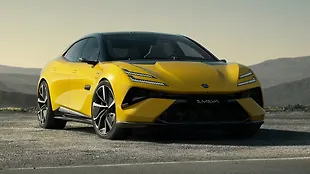Tata Motors design studio visit
Tata Motors recently invited journalists to take a glimpse of their design studio in Pune. Only about a 100 employees of the 24,000 strong workforce have seen the insides of this design house. So you can imagine how important this event was for the car maker to share their work and achievements.

Pratap Bose, head of design, Tata Motors, said, “The world around us has changed rapidly and to face this kind of challenge, we at Tata Motors, and especially the design team had to create the three P’s – People, Place and Process. Tiago was literally the first one to come through this process and we can already see the results through the 23,000 bookings bagged in eight weeks.”

Pratap also introduced key members in the Tiago design team - Tony Hunter, Graham Gest, Sandeep Karyakarte, Salil Kulkarni and Shilpa Bandyopadhyay. They worked closely with the three studios in Pune, United Kingdom and Italy, to deliver the Tiago the way we see it today. The studio in Pune is the most equipped simply because this is where the cars are put to production.

Pratap revealed that for the Tiago to succeed, it was important for them to reach a certain set of customers. Buyers to whom they were not talking to - the younger demographic group. He said, “We also found out that women were not buying Tata cars. Strong, sturdy, solid cars was seen as a problem, and women did not find them easy or agile to drive. So there were some things that we had to re-balance to address this new segment of the market.” Bose proudly added, “The hook on the passenger side of the centre console is there to hold a ladies handbag. This is so that the bag does not fall off the seat when the brakes are applied. You see, you just can’t get a bigger piece of a pie if you can’t address more people."

Salil Kulkarni, design project manager, Tata Motors, said, “Orange and red are the only colours that have the unique colour co-ordinated vents. A majority of the car buyers in India play safe when it comes to colours. So, a customer would ideally not appreciate if his white car came with white vents. However, if someone is bold enough to buy an orange or a red car, they’d want to be open about it which is why we opted to put those coloured vents there. Even if a user wants it changed, the part can be painted at the dealer. There’s a total of ten parts on the interiors which can be pulled off at the dealer and painted to any colour. It allows you to make your car your own, which is unique."

Pratap then brought us to the where the 40 per cent scale of the Tiago was made in clay. “The designer draws and sculpts with the use of a knife, other tools and a styling tape that bends. The sculptor then cleans the surface after the lines are made around the tape, like power bulges for example. Post this, a digital picture is taken and the design is now declared digital. It is now shared with the rest of the team and we carry on building it on the software, with reference points to other departments like for example crash testing”, he said. “However, we move to a full sized model quickly because that’s where you can really appreciate the design elements. The 40 per cent scale is more about finding a theme. To see if the lines are okay or if the proportion is fine. Once the theme is identified, we blow it up and we make those full sized models which are then perfected and worked upon," Pratap let on.

Designers also come up with a grain selection that was seen somewhere. The department decodes what grain it is and what it means in terms of standard pantone shade. This is so that the industry and the supplier will understand. It is then converted into a ‘design master’. A design master is something that can be replicated with the same formula in multiple places. Once the design master is done in terms of colour, then it is worked out for different materials. The interiors of a car has at least ten different types of plastics. After moulding is over, when these plastics come together, they should have the same grain. Now each plastic has a different nature when it is put into the injection mould. The temperature profile varies. Colours are very temperature sensitive. It needs monitoring to make sure that after moulding it should be left with a common grain. Colours read differently with different grains. Colour is one aspect. So is controlled gloss. Most car companies in one segment source more or less the same raw materials. However, the grains change and if you look at the cars, you may say ones plastic looks cheap while the other looks costly.

The elements that contribute to that is the glossy finish. If something is too shiny, the normal attitude is that it is cheap. Other than chrome of course. Gloss needs to be controlled. The moment the designers start sketching, the back end team starts tracking what issues that can crop up. If two parts are being put together, one a very large part and the other a very different material, dimensional control could pose a problem. The team actually highlights this stating that there could be a dimensional issue on the gap.

Sandeep Karyakarte, head of passenger car design, Tata Motors, “If the refection pattern on the body panels like a door, is not even, then it will be perceived as poor quality. This has more to do with the senses. Senses include visual, tactile, fit and finish, sound (sound of door closing). The door may be as safe as any other door. But if the elements of perception are not there, it will convey a wrong sense of quality even though it may be reliable. We start with these elements and debug them.”

It is obvious that Tata Motors is on a roll to convey their design and engineering expertise to the market and industry. And going by the efforts put into the Tiago, it sure looks like the Kite5, Hexa and Nexon also promise to stand up to their new philosophy.
Pictures: Santosh Nair and Venkat Desirazu

![Tata Nexon [2017-2020] Image Tata Nexon [2017-2020] Image](https://imgd.aeplcdn.com/272x153/cw/ec/42611/Tata-Nexon-Exterior-172215.jpg?wm=0&q=80)
![Tata Nexon [2017-2020] Right Front Three Quarter Tata Nexon [2017-2020] Right Front Three Quarter](https://imgd.aeplcdn.com/199x112/cw/ec/16868/Tata-Nexon-Right-Front-Three-Quarter-107996.jpg?v=201711021421&q=80)
![Tata Nexon [2017-2020] Right Front Three Quarter Tata Nexon [2017-2020] Right Front Three Quarter](https://imgd.aeplcdn.com/199x112/ec/D5/EB/16868/img/ol/Tata-Nexon-Right-Front-Three-Quarter-44113.jpg?v=201711021421&q=80)
![Tata Nexon [2017-2020] Right Rear Three Quarter Tata Nexon [2017-2020] Right Rear Three Quarter](https://imgd.aeplcdn.com/199x112/ec/D5/EB/16868/img/ol/Tata-Nexon-Right-Rear-Three-Quarter-44117.jpg?v=201711021421&q=80)
![Tata Nexon [2017-2020] Dashboard Tata Nexon [2017-2020] Dashboard](https://imgd.aeplcdn.com/199x112/cw/ec/16868/Tata-Nexon-Dashboard-108004.jpg?v=201711021421&q=80)
![Tata Nexon [2017-2020] Dashboard Tata Nexon [2017-2020] Dashboard](https://imgd.aeplcdn.com/468x263/cw/ec/16868/Tata-Nexon-Dashboard-133391.jpg?wm=0&q=80)























